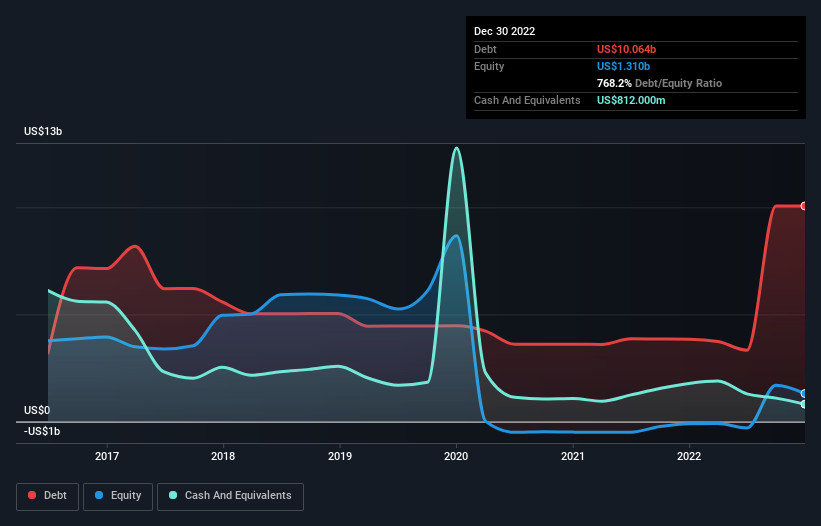- United States
- /
- Software
- /
- NasdaqGS:GEN
These 4 Measures Indicate That Gen Digital (NASDAQ:GEN) Is Using Debt Extensively

Legendary fund manager Li Lu (who Charlie Munger backed) once said, 'The biggest investment risk is not the volatility of prices, but whether you will suffer a permanent loss of capital.' So it might be obvious that you need to consider debt, when you think about how risky any given stock is, because too much debt can sink a company. As with many other companies Gen Digital Inc. (NASDAQ:GEN) makes use of debt. But the real question is whether this debt is making the company risky.
Why Does Debt Bring Risk?
Debt assists a business until the business has trouble paying it off, either with new capital or with free cash flow. Part and parcel of capitalism is the process of 'creative destruction' where failed businesses are mercilessly liquidated by their bankers. However, a more common (but still painful) scenario is that it has to raise new equity capital at a low price, thus permanently diluting shareholders. Of course, the upside of debt is that it often represents cheap capital, especially when it replaces dilution in a company with the ability to reinvest at high rates of return. When we examine debt levels, we first consider both cash and debt levels, together.
See our latest analysis for Gen Digital
How Much Debt Does Gen Digital Carry?
You can click the graphic below for the historical numbers, but it shows that as of December 2022 Gen Digital had US$10.1b of debt, an increase on US$3.84b, over one year. However, it does have US$812.0m in cash offsetting this, leading to net debt of about US$9.25b.

How Strong Is Gen Digital's Balance Sheet?
According to the last reported balance sheet, Gen Digital had liabilities of US$2.88b due within 12 months, and liabilities of US$11.3b due beyond 12 months. Offsetting these obligations, it had cash of US$812.0m as well as receivables valued at US$398.0m due within 12 months. So it has liabilities totalling US$13.0b more than its cash and near-term receivables, combined.
When you consider that this deficiency exceeds the company's huge US$11.3b market capitalization, you might well be inclined to review the balance sheet intently. In the scenario where the company had to clean up its balance sheet quickly, it seems likely shareholders would suffer extensive dilution.
In order to size up a company's debt relative to its earnings, we calculate its net debt divided by its earnings before interest, tax, depreciation, and amortization (EBITDA) and its earnings before interest and tax (EBIT) divided by its interest expense (its interest cover). Thus we consider debt relative to earnings both with and without depreciation and amortization expenses.
With a net debt to EBITDA ratio of 6.4, it's fair to say Gen Digital does have a significant amount of debt. But the good news is that it boasts fairly comforting interest cover of 5.1 times, suggesting it can responsibly service its obligations. We saw Gen Digital grow its EBIT by 7.6% in the last twelve months. Whilst that hardly knocks our socks off it is a positive when it comes to debt. The balance sheet is clearly the area to focus on when you are analysing debt. But it is future earnings, more than anything, that will determine Gen Digital's ability to maintain a healthy balance sheet going forward. So if you want to see what the professionals think, you might find this free report on analyst profit forecasts to be interesting.
But our final consideration is also important, because a company cannot pay debt with paper profits; it needs cold hard cash. So it's worth checking how much of that EBIT is backed by free cash flow. Over the last three years, Gen Digital reported free cash flow worth 9.5% of its EBIT, which is really quite low. That limp level of cash conversion undermines its ability to manage and pay down debt.
Our View
We'd go so far as to say Gen Digital's net debt to EBITDA was disappointing. But on the bright side, its EBIT growth rate is a good sign, and makes us more optimistic. We're quite clear that we consider Gen Digital to be really rather risky, as a result of its balance sheet health. For this reason we're pretty cautious about the stock, and we think shareholders should keep a close eye on its liquidity. There's no doubt that we learn most about debt from the balance sheet. However, not all investment risk resides within the balance sheet - far from it. We've identified 5 warning signs with Gen Digital (at least 1 which makes us a bit uncomfortable) , and understanding them should be part of your investment process.
When all is said and done, sometimes its easier to focus on companies that don't even need debt. Readers can access a list of growth stocks with zero net debt 100% free, right now.
New: Manage All Your Stock Portfolios in One Place
We've created the ultimate portfolio companion for stock investors, and it's free.
• Connect an unlimited number of Portfolios and see your total in one currency
• Be alerted to new Warning Signs or Risks via email or mobile
• Track the Fair Value of your stocks
Have feedback on this article? Concerned about the content? Get in touch with us directly. Alternatively, email editorial-team (at) simplywallst.com.
This article by Simply Wall St is general in nature. We provide commentary based on historical data and analyst forecasts only using an unbiased methodology and our articles are not intended to be financial advice. It does not constitute a recommendation to buy or sell any stock, and does not take account of your objectives, or your financial situation. We aim to bring you long-term focused analysis driven by fundamental data. Note that our analysis may not factor in the latest price-sensitive company announcements or qualitative material. Simply Wall St has no position in any stocks mentioned.
About NasdaqGS:GEN
Gen Digital
Engages in the provision of cyber safety solutions for consumers in the United States, Canada, Latin America, Europe, the Middle East, Africa, the Asia Pacific, and Japan.
Good value slight.
Similar Companies
Market Insights
Community Narratives


